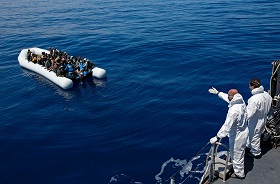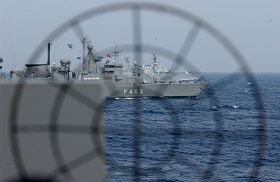In recent years, the European Union has faced a growing threat to the security of its external borders. Thus, the traditional threats posed by the uncontrolled entry into the EU of illegal immigrants fleeing wars and disastrous economic situations in their home countries are being aggravated by the penetration of extremist groups in the EU, who are recruiting EU citizens to participate in regional armed conflicts.
In recent years, the European Union has faced a growing threat to the security of its external borders.
According to a Report from the Commission to the European Parliament and the Council covering the period from November 2013 to February 2014, the number of detected violations of its external borders increased by 96% in comparison with the previous period. The Report notes not only an increased number of illegal immigrants, but also an expanded range of potential threats to border security.
Thus, the traditional threats posed by the uncontrolled entry into the EU of illegal immigrants fleeing wars and disastrous economic situations in their home countries are being aggravated by the penetration of extremist groups in the EU, who are recruiting EU citizens to participate in regional armed conflicts. According to some experts, fighters from the Islamic State have already begun to infiltrate the flow of migrants traveling from North Africa to Europe across the Mediterranean.
Given the complex nature of the threat of extremism’s penetration into the EU, the measures to address it are not limited to strengthening the effectiveness of control over external borders, as many members of extremist groups have EU citizenship and reside on its territory. Therefore, just tightening the EU external borders control cannot solve this problem. At the same time, more efficient management of external borders security should be viewed as an integral part of the package of measures to combat manifestations of extremism in Europe.
The notion of strengthening external borders includes two main components: improving the effectiveness of border control at checkpoints (the EU external borders control) and strengthening the so-called green and blue border security beyond EU checkpoints (protection of the external borders of the EU).
The functions of border protection and control within the EU are carried out by national border services. Legislation on border control is adopted at the EU level, while regulations governing the protection of borders are still set by member states at national level.
The European Union has recently undertaken efforts to reform the legislation on border control and border protection in order to make the EU's external borders more secure and the system of passes more efficient.
The ”Smart Borders” Package is the EU’s key initiative in recent years in the field of border control. The Package aims to improve the management of external borders and includes the establishment of two main components, namely an Entry/Exit System and a Registered Traveler Program. In February 2013, the European Commission prepared two proposals for Regulations of the European Parliament and of the Council, establishing a Registered Traveler Program and an Entry/Exit System.
An Entry/Exit System entails the creation of a single electronic system for the registration of all incoming and outgoing third-country nationals admitted to the EU for a short stay. In accordance with the proposal, an Entry/Exit System has two levels: national and central. The data contained in the system should be available to immigration authorities and border services of all member states. Among other things, the new system should considerably simplify the identification of illegal immigrants trying to enter the EU or those who are already residing in it.
An Entry/Exit System is oriented towards bona fide and law-abiding foreigners who visit the Schengen area on a regular basis. Any person meeting the above criteria may apply to the Border Guard Service or a Consular Office of a member state for inclusion in the program. Being a Member of the Program status entitles a third-country national to cross the border using a simplified, automatic procedure.
The European Border Surveillance System (Eurosur) adopted by the European Parliament and of the Council in its Regulation of October 2013 appears to be one of the recent initiatives in the field of EU’s monitoring external borders [1]. This system focuses mainly on the southern maritime and eastern land borders of the EU. However, in the future, it will be extended to the rest of the EU borders. As of today, 18 EU member states as well as Norway have joined the Eurosur program.
EUROSUR is primarily a mechanism for facilitating cooperation and exchange of information, which helps member states secure their external borders, and promotes tactical, operational and strategic cooperation within the framework of FRONTEX, the EU Agency that manages cooperation between national border guards. In fact, this system does not create a new structure of management for external borders and does not replace existing systems. It is aimed at streamlining existing national systems of border protection to prevent illegal border crossings, to combat cross-border crime and to save the lives of immigrants.
The rapid exchange of real-time information allows EU member states as well as FRONTEX to gain a situational picture of all sections of the external borders of the EU and to respond quickly and efficiently to violations or emergencies at the border. In other words, Eurosur solves problems of an intellectual nature, while leaving issues of technical support as the responsibility of member states.
However, the events of recent months (April – May 2015) have shown that Eurosur is not always able to meet challenges without fail. In April 2015, a smuggler’s boat with hundreds of refugees sank in the Mediterranean on the way from North Africa to Europe. This tragedy compelled European officials to address this problem again and on April 23, 2015 a Special Meeting of the European Council was convened on the issue of preventing illegal migration flows. The European Council outlined a number of drastic measures to prevent the entry into the EU of illegal immigrants, including the capture and destruction of vessels before they are used by traffickers.
Such initiatives have immediately provoked much controversy regarding compliance with international law. Obviously, sinking ships in international waters is possible only if the relevant UN Security Council resolution gives the right to do so. In addition, it is unclear how the relevant services of the EU countries plan to identify the vessels used for immigrants’ trafficking.
Moreover, this measure is unlikely to solve the problem of preventing entry of representatives of extremist groups into the EU, since the European Council intends to launch a program of international protection for immigrants from North Africa within the framework of internal solidarity and responsibility efforts. This program provides for granting immigrants refugee status and their resettlement in all EU countries, which has been opposed adamantly by a number of countries, including Britain, for they fear the mass entry of extremists into the EU.
1. There is little doubt that the problem of illegal immigration into the European Union has acquired a new nature. The fire set in the Middle East and North Africa is gradually spreading to the EU. In addition to the growth of illegal immigration flows, the European Union also has to combat extremism’s penetration into Europe, which is a much more complex and difficult problem to solve.Regulation (EU) No 1052/2013 of the European Parliament and of the Council of 22 October 2013 establishing the European Border Surveillance System (Eurosur), OJ L 295, 6.11.2013, p. 11–26.







